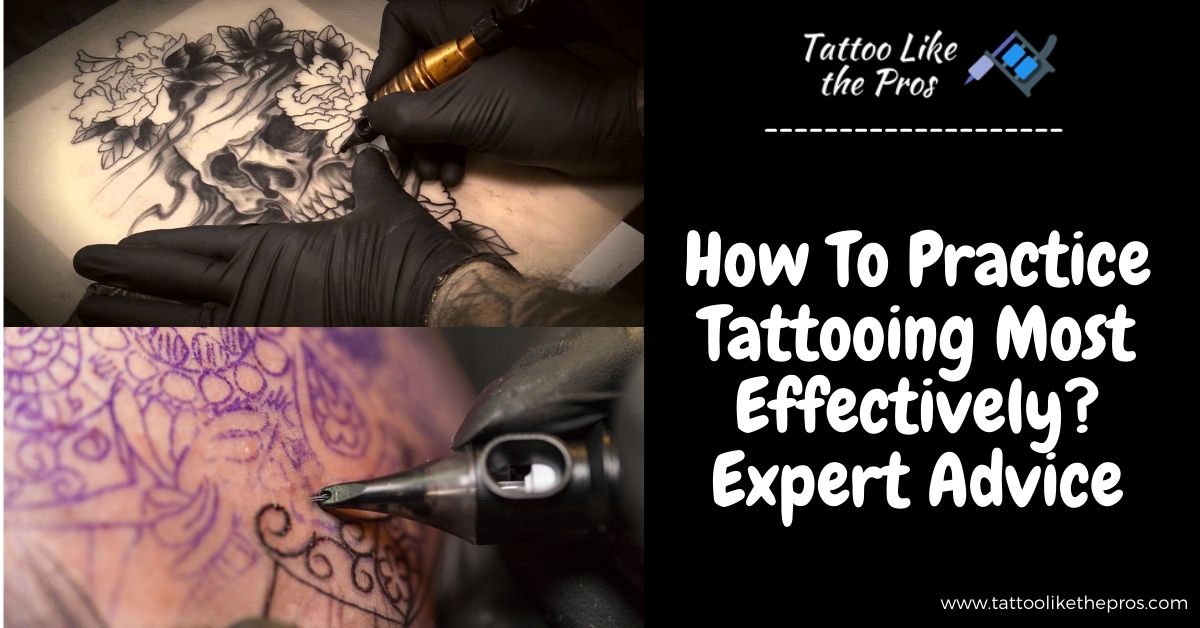As with any form of art, tattooing skills improve with time and practice. For tattooists’ learning their art is a lifelong process. Tattoo enthusiasts can’t just trust anybody with their fullback, sleeve, or chest tattoo design. They are careful to select only an experienced, well-known artist for the job. In this article, you’ll learn how to practice tattooing so that you can become an expert from the get-go.
It’s crucial to practice tattooing sufficiently before taking on your first client. You wouldn’t want to disappoint a client that trusts you fully in getting their dream tattoo design.
One common mistake rookie artists make leads to the phenomenon of tattoo blowout. The blowout is a smudgy outcome of the design caused by the inexperienced artist’s heavy-handedness and inefficient handling of the tattoo machine.
The focus of this article is to make you well-prepared to ink your clients wonderfully so that they not only value your work but also send you other clients.
So, how do you practice tattooing most effectively as a starter? To start with, you’ll need a fabulous beginners kit; as for the rest, let’s delve into it pronto!
How To Practice Tattooing?
#1. Practice Drawing

Rigorous practice makes you accustomed to a task and makes you better at it in each subsequent repetition. The same holds for drawing tattoo designs. To make tattooing your new career and flourish at it, you need to devote multiple hours to learning the craft of drawing well.
Practicing drawing with a marker is an excellent initial step, but it’s not something that will take you far in the tattooing world. When you eventually tattoo, you’ll be using a tattoo machine, which is much heavier to hold steady than a typical marker while drawing.
The suggested method is to practice drawing with a pencil (and later a pen) that is weighted so that it’s closer to the feeling of a tattoo machine. It would be practical to attach about 85 grams of metal rings around the top section of the pencil (or pen) to simulate using an actual tattoo machine.
Further, it would help if you progressed from drawing on paper to drawing on contoured surfaces. Practicing on the latter gives you the practice needed for drawing on body part-type surfaces. For doing so, you can use fruits or synthetic tattoo practice skin. Fruits that suffice for the procedure include apples, oranges, grapefruit, melon, or banana.

Once you’ve practiced enough times to become confident of your drawing skills, you can progress to the next level of practice — drawing with henna or a nonpermanent marker. A friend, or yourself, instead of a client, fruit, or practice skin should be the place to practice at this stage. While using henna, ensure it is either red or brown. Black henna is a banned product due to its allergy-inducing ingredients.
After trying multiple designs on yourself and your friends, be sure to collect others’ feedback and make the required improvements each subsequent time you practice. Once you’ve mastered this step, you need to start practicing with an actual tattooing machine.
#2. Make The Progression To A Tattoo Machine

For this stage and the previous, you can practice using self-created designs or copied from Instagram or Pinterest. Here again, although you’ll be using a real tattoo machine (i.e., a much heavier object), you should practice on contoured fruits or practice skin (even synthetic arms). Using a tattoo machine to practice is an excellent way to build a steady and robust hand movement essential for actual tattooing.
#3. Get Used To All Types Of Tattoo Equipment

To become a tattooist, getting used to a tattoo machine isn’t all that is required. There are several other tools, equipment, and accessories a tattooist should know how to use in a studio setup.
At this learning juncture, a beginner won’t have access to all types of equipment. However, a diligent online search would yield beneficial results. You would learn about the usage, handling, and look of specific equipment and accessories that you would eventually be using during your apprenticeship and beyond.
You can search the internet for different tattoo machines (rotary, machine, pen, shader, liner, pneumatic) through credible online resources. You can also get information on tattoo kits and learn about all the essential equipment and accessories (colored ink, gloves, tattoo lamp, etc. ) needed to ink clients.
#4. Get An Apprenticeship

Once you’ve practiced enough using the above techniques, it would be awesome to do an apprenticeship under your favorite, willing artist. The artist would agree to onboard you once you’ve proven your mettle through your — hopefully comprehensive — portfolio of sketches.
Some tattoo artists charge for the apprenticeship. Others may charge nothing. Further, some even pay you for learning and working under them for a year to a few years. But, you can rest assured, through an apprenticeship, you’ll learn everything you need to know before you can service your first clients.
Also Read: Best Tattoo Numbing Spray of 2021 with Reviews
Conclusion
Tattoos are permanent. That’s enough reason to push the notion that becoming an expert tattooist is the only viable option for budding tattooists. Extensive practice and gradual progression from one step to another along the path of becoming a client-facing tattooist are essential in making tattooing a career.
When it comes to learning how to practice tattooing most effectively, you should follow all the above steps. The sooner you adhere to them, the sooner you’ll become an expert. The key to success once again is practice, practice, and more practice, while maintaining patience. The dedication and patience will pay off when your first client tells you and others how good you are.
